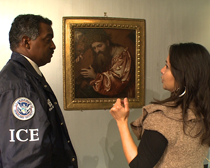 TALLAHASSEE, Fla. — A 400-year-old masterpiece work of art taken illegally from its owners in Nazi-occupied France during World War II was returned today to the family from which it was stolen more than 70 years ago.
TALLAHASSEE, Fla. — A 400-year-old masterpiece work of art taken illegally from its owners in Nazi-occupied France during World War II was returned today to the family from which it was stolen more than 70 years ago.Officials from U.S. Immigration and Customs Enforcement's (ICE) Homeland Security Investigations (HSI), the U.S. Attorney's Office for the Northern District of Florida, and Interpol Washington's U.S. National Central Bureau attended a ceremony in Tallahassee April 18 to return the rare painting by Girolamo de' Romani, known as Romanino, to the Gentili family.
HSI Tampa Special Agent in Charge Susan McCormick and U.S. Attorney Pamela Marsh, Northern District of Florida, officially signed over custody of the painting the same day to the Gentili heirs' legal representative, Maître Corinne Hershkovitch, who traveled from France to receive the artwork.
The painting, "Cristo Portacroce" (Christ Carrying the Cross), which dates to circa 1538, depicts Christ, crowned with thorns and wearing a striking copper-colored silk robe, carrying the cross on his right shoulder while being dragged with a rope by a soldier.
"Thanks to the tireless efforts of those involved, we are now righting a wrong perpetrated more than 70 years ago," said McCormick. "HSI will continue to investigate cases involving stolen art and cultural property from around the world and return the objects to their rightful owners."
Professor Lionel Salem, one of the heirs of the Gentili estate, could not be present for the ceremony but expressed his appreciation to the Department of Homeland Security for their "fantastic work" in investigating and pursuing the family's interest in the Romanino painting: "I am so deeply grateful for the efforts of DHS on this matter," he said. "The Gentili heirs are unanimous in wishing to convey the full extent of their immense gratitude."
"Today, during this momentous occasion, I commend the outstanding collaborative efforts of ICE/HSI, the U.S. Attorney's Office for the Northern District of Florida, and Interpol Washington for locating and returning this 400-year-old priceless piece of artwork to the Gentili family where it belongs. When law enforcement agencies partner and pull their respective resources, much can be accomplished at all levels," stated Interpol Washington Director Timothy A. Williams.
The painting was imported into the United States in March 2011 for temporary exhibit at the Mary Brogan Museum of Art and Science in Tallahassee. Following a lead from Interpol that called the painting's ownership into question, HSI special agents consulted the U.S. Attorney's Office and seized the painting at the museum Nov. 4, 2011, to protect the art until ownership could be confirmed through formal legal proceedings. B-roll of the seizure can be downloaded here.
The painting had been on display at the museum since March 18, 2011, as part of an exhibition of 50 baroque paintings on loan from the Pinacoteca di Brera in Milan, Italy.
The painting is among many works of art and other valuable items, taken in a forced sale from the estate of Federico Gentili di Giuseppe. Gentili died of natural causes in Paris in April 1940, just months before the Nazi army invaded France in 1941. After receiving advanced warning of the impending Nazi invasion, Federico Gentili's children and grandchildren fled from France, escaping to Canada and the United States. Other family members, who were unable to flee, died in concentration camps.
Gentili's grandchildren have taken legal steps internationally to find and reclaim works illegally taken from their family during the Nazi occupation. In a landmark 1999 decision relating to World War II plunder, a Paris Court of Appeals forced the Musee de Louvre in Paris to return five paintings to the Gentili family, and ruled that the auction of the Gentili estate in Nazi-occupied France was an illegal forced sale and a "nullity."
Earliest records about the painting indicate that it dates back to around 1538. It then appears in the collection of Antonio and Cesare Averoldi, and then in the Crespi Galerie. On June 4, 1914, after legally exporting a portion of the Crespi Collection from Italy, the Crespi Galerie put this painting and others up for auction in Paris, where it was subsequently purchased by Federico Gentili. After Gentili died, his estate was auctioned by French Vichy authorities in 1941, acting in concert with the Nazi occupiers; and the Gentili heirs were prohibited by law from returning to claim the painting. Several extraordinary anti-Semitic laws had been imposed, depriving French nationals who had left France of their nationality and arranging for confiscation of their property. Another German order, dated Sept. 27, 1940, established that, "Jews who had fled from the occupied zone were banned from returning there." As a result, the painting was sold in the illegal, forced sale of 1941. The painting was thereafter acquired by the Pinacoteca di Brera in 1998.
U.S. Attorney Marsh and Assistant U.S. Attorney Bobby Stinson prosecuted the federal case for the United States.
 U.S. Attorney Marsh praised the investigation by Interpol and HSI agents that brought this long-standing injustice to light: "Interpol and HSI deserve special credit for their efforts on this case. Their investigation not only identified the presence of this looted artwork in our district but also confirmed many details that were essential to a successful legal outcome. They obtained evidence from several different countries and also obtained documentation that confirmed the legal exportation of this painting from Italy prior to its sale to the Gentili family in France. It is not every day that our agents are required to track down and verify the provenance of a Renaissance painting. It was an unusual and dated investigative trail, but they were up to the challenge."
U.S. Attorney Marsh praised the investigation by Interpol and HSI agents that brought this long-standing injustice to light: "Interpol and HSI deserve special credit for their efforts on this case. Their investigation not only identified the presence of this looted artwork in our district but also confirmed many details that were essential to a successful legal outcome. They obtained evidence from several different countries and also obtained documentation that confirmed the legal exportation of this painting from Italy prior to its sale to the Gentili family in France. It is not every day that our agents are required to track down and verify the provenance of a Renaissance painting. It was an unusual and dated investigative trail, but they were up to the challenge."HSI plays a leading role in criminal investigations that involve the unauthorized importation and distribution of cultural property, as well as the illegal trafficking of artwork. The agency specializes in recovering works that have been reported lost or stolen. The HSI Office of International Affairs, through its 70 attaché offices in 47 countries, works closely with foreign governments to conduct joint investigations, when possible.
HSI specially trained investigators, assigned to both domestic and international offices, partner with governments, agencies and experts to protect cultural antiquities. They also train investigators from other nations and agencies on investigating crimes involving stolen property and art, and how to best enforce the law to recover these items when they emerge in the marketplace.
Since 2007, HSI has repatriated more than 2,500 items to more than 23 countries.







No comments:
Post a Comment